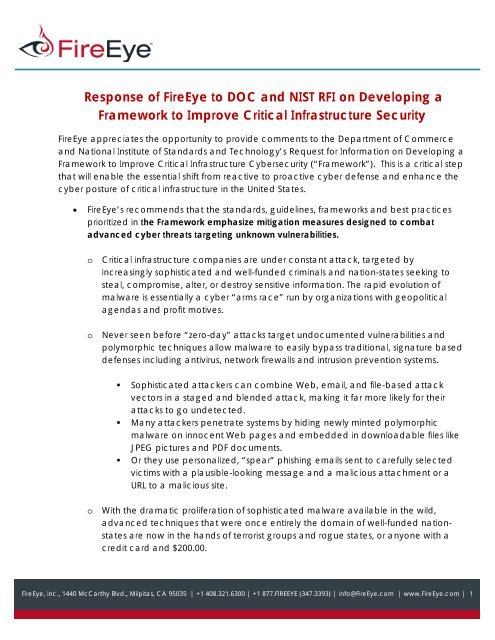RFI Comments - FireEye - Computer Security Resource Center
RFI Comments - FireEye - Computer Security Resource Center
RFI Comments - FireEye - Computer Security Resource Center
Create successful ePaper yourself
Turn your PDF publications into a flip-book with our unique Google optimized e-Paper software.
Response of <strong>FireEye</strong> to DOC and NIST <strong>RFI</strong> on Developing a<br />
Framework to Improve Critical Infrastructure <strong>Security</strong><br />
<strong>FireEye</strong> appreciates the opportunity to provide comments to the Department of Commerce<br />
and National Institute of Standards and Technology’s Request for Information on Developing a<br />
Framework to Improve Critical Infrastructure Cybersecurity (“Framework”). This is a critical step<br />
that will enable the essential shift from reactive to proactive cyber defense and enhance the<br />
cyber posture of critical infrastructure in the United States.<br />
• <strong>FireEye</strong>’s recommends that the standards, guidelines, frameworks and best practices<br />
prioritized in the Framework emphasize mitigation measures designed to combat<br />
advanced cyber threats targeting unknown vulnerabilities.<br />
o Critical infrastructure companies are under constant attack, targeted by<br />
increasingly sophisticated and well-funded criminals and nation-states seeking to<br />
steal, compromise, alter, or destroy sensitive information. The rapid evolution of<br />
malware is essentially a cyber “arms race” run by organizations with geopolitical<br />
agendas and profit motives.<br />
o Never seen before “zero-day” attacks target undocumented vulnerabilities and<br />
polymorphic techniques allow malware to easily bypass traditional, signature based<br />
defenses including antivirus, network firewalls and intrusion prevention systems.<br />
Sophisticated attackers can combine Web, email, and file-based attack<br />
vectors in a staged and blended attack, making it far more likely for their<br />
attacks to go undetected.<br />
Many attackers penetrate systems by hiding newly minted polymorphic<br />
malware on innocent Web pages and embedded in downloadable files like<br />
JPEG pictures and PDF documents.<br />
Or they use personalized, “spear” phishing emails sent to carefully selected<br />
victims with a plausible-looking message and a malicious attachment or a<br />
URL to a malicious site.<br />
o With the dramatic proliferation of sophisticated malware available in the wild,<br />
advanced techniques that were once entirely the domain of well-funded nationstates<br />
are now in the hands of terrorist groups and rogue states, or anyone with a<br />
credit card and $200.00.<br />
<strong>FireEye</strong>, Inc., 1440 McCarthy Blvd., Milpitas, CA 95035 | +1 408.321.6300 | +1 877.FIREEYE (347.3393) | info@<strong>FireEye</strong>.com | www.<strong>FireEye</strong>.com | 1
o Based on <strong>FireEye</strong>’s research, organizations are experiencing explosive growth in<br />
these kinds of attacks. On average, organizations are experiencing 221 web-based<br />
malicious events per week that successfully evade traditional defenses. Compared<br />
to the second half of 2011, the number of events per organization rose by 225% in<br />
the first half of 2012. Malware is so prevalent that, on average, enterprises<br />
experience a malware-related event once every three minutes.<br />
• <strong>FireEye</strong> recommends that the Framework include a section on standards and best<br />
practices that counter advanced adversary tactics and techniques such as targeted<br />
spear phish, zero-day and blended attacks. This section should emphasize automated,<br />
proactive and dynamic defense by incorporating the following as baseline standards<br />
and best practices:<br />
o Signature-less, proactive defense that detects and blocks unknown cyberattacks<br />
over the lifecycle of an attack as a necessary complement to traditional,<br />
signature based defenses such as firewalls, intrusion prevention systems, web and<br />
email gateways and anti-virus software. Recommended attributes of such tools<br />
include the ability to:<br />
Identify and block in-bound zero day attacks across multiple threat<br />
vectors;<br />
Expose the entire attack life cycle by correlating intelligence across<br />
various threat vectors;<br />
Block outreach from a compromised host to its command and control<br />
center;<br />
Prevent the exfiltration of data and the download of additional malware;<br />
Eliminate false positives; and<br />
Produce complete forensic details.<br />
o Tools that provide automated sharing of indicators of compromise in near real<br />
time at the local, enterprise and global levels.<br />
o Virtualization techniques for the identification of known and unknown malware as<br />
described in <strong>Security</strong> Control 44, Detonation Chambers, which was recently<br />
added to NIST Special Publication 800.53, Revision 4 (Final Public Draft)<br />
Recommended <strong>Security</strong> Controls for Federal Information Systems and<br />
Organizations. The Supplemental Guidance to <strong>Security</strong> Control 44 provides:<br />
<strong>FireEye</strong>, Inc., 1440 McCarthy Blvd., Milpitas, CA 95035 | +1 408.321.6300 | +1 877.FIREEYE (347.3393) | info@<strong>FireEye</strong>.com | www.<strong>FireEye</strong>.com | 2
Detonation chambers, also known as dynamic execution<br />
environments, allow organizations to open email attachments,<br />
execute untrusted applications, and/or execute Universal <strong>Resource</strong><br />
Locator (URL) requests in the safety of an isolated environment. These<br />
protected and isolated execution environments provide a means of<br />
determining whether the associated attachments/applications<br />
contain malware. While related to the concept of deception nets, the<br />
control is not intended to maintain a long-term environment in which<br />
adversaries can operate and their actions can be observed. Rather, it<br />
is intended to quickly identify malware and reduce the likelihood of<br />
malware spreading to user environments of operation.<br />
• <strong>FireEye</strong> further recommends that the Framework embrace innovation and encourage<br />
the rapid adoption of new capabilities by critical infrastructure companies and<br />
government initiatives that enhance protections for critical infrastructure. To further<br />
these imperatives, <strong>FireEye</strong> recommends that the Framework be updated frequently to<br />
incorporate new and innovative capabilities that mitigate risk from emerging threats.<br />
<strong>FireEye</strong>, Inc., 1440 McCarthy Blvd., Milpitas, CA 95035 | +1 408.321.6300 | +1 877.FIREEYE (347.3393) | info@<strong>FireEye</strong>.com | www.<strong>FireEye</strong>.com | 3
















